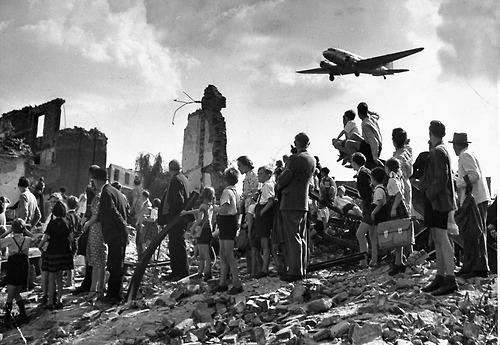Tempelhof Airport was closed for public air traffic in October 2008. 85 years earlier, in October 1923, ‘the first commercial airport worldwide’ was inaugurated by the German Reich’s Ministry of Transport; the initial route operated to Koenigsberg (now Kaliningrad) in former East Prussia. The first plane of the newly founded “Deutsche Luft Hansa” had its maiden voyage from Berlin to Zurich in 1926 and even gigantic Zeppelins majestically raised from the vast Tempelhof airfield. By the 1930s, it had developed into Europe’s busiest airport – ranging ahead of Paris, Amsterdam and London. But Tempelhof is unforgotten for the dramatic role it was to play in post-war Germany.
At the time, Berlin still largely lies in ruins. It is carved up between and occupied by the four victorious allied powers – the USA, Britain, France and Soviet Russia. In the western occupied sectors of the city the currency reform in June 1948 sees the introduction of the Deutschmark replacing the old Reichsmark. Russia, in the eastern sector, feels sidelined and decides to retaliate with a blockade: all road, rail and water-way transport connections into the western sectors of Berlin are deliberately disrupted or completely severed, electricity is cut off and two million people still suffering after years of deprivation during WW II, suddenly find themselves isolated from all sources of supply.
Airlifts for bare necessities lasted 322 days

The Tempelhof Airlift. Photo: Henry Ries, who died in 2004.
Chocolates by parachute
The reaction by the American military governor, General Lucius D. Clay, is immediate. He initiates “Operation Vittles”, thus ensuring survival of allied service personnel and civilians of the western sectors alike. The first American airfreighter lands on June 26, 1948; later, up to 50 aircraft simultaneously are crowding the skies over Berlin. During the April 1949 “Easter Parade”, 12,000 tonnes of supplies are flown in by means of nearly 4,000 take-offs and landings. There is also “Little Vittles”: when US pilot Gail Halvorsen happily dips the wings of his aircraft Spirit of Freedom – the ‘Rosinenbomber’ – to wave Hello, the faces of thousands of children expectantly brighten up: Tiny parachutes made from handkerchiefs are circling through the air like snowlakes – carrying a long-missed freight: sweets!
“People of this world… look upon this city…” (Ernst Reuter)
Many of the pilots lose their lives during „Operation Vittles“. The Soviets lift the blockade in May of 1949 and the aid is discontinued in September. This unparalleled relief effort is still considered the most remarkable logistical challenge to aviation in history. It clicked like clockwork, with the planes maintaining a regular 90 seconds between landings despite frequent disruption emanating from the Soviet sector. 2008 saw the 60th anniversary of the airlift. It was worthily remembered during the International Aerospace Exhibition (ILA) held in Berlin. With Gail Halvorsen as a guest of honour.
Since its closure, Tempelhof Airport has become a much sought-after venue for events and exhibitions. The vast airfield, now the ‘Tempelhofer Feld’ or ‘Tempelhofer Freiheit (Freedom)’, has evolved into one of Berlin’s favourite open-air locations.
Text and header photo: ©Christina Feyerke
Article first published in 2008.
